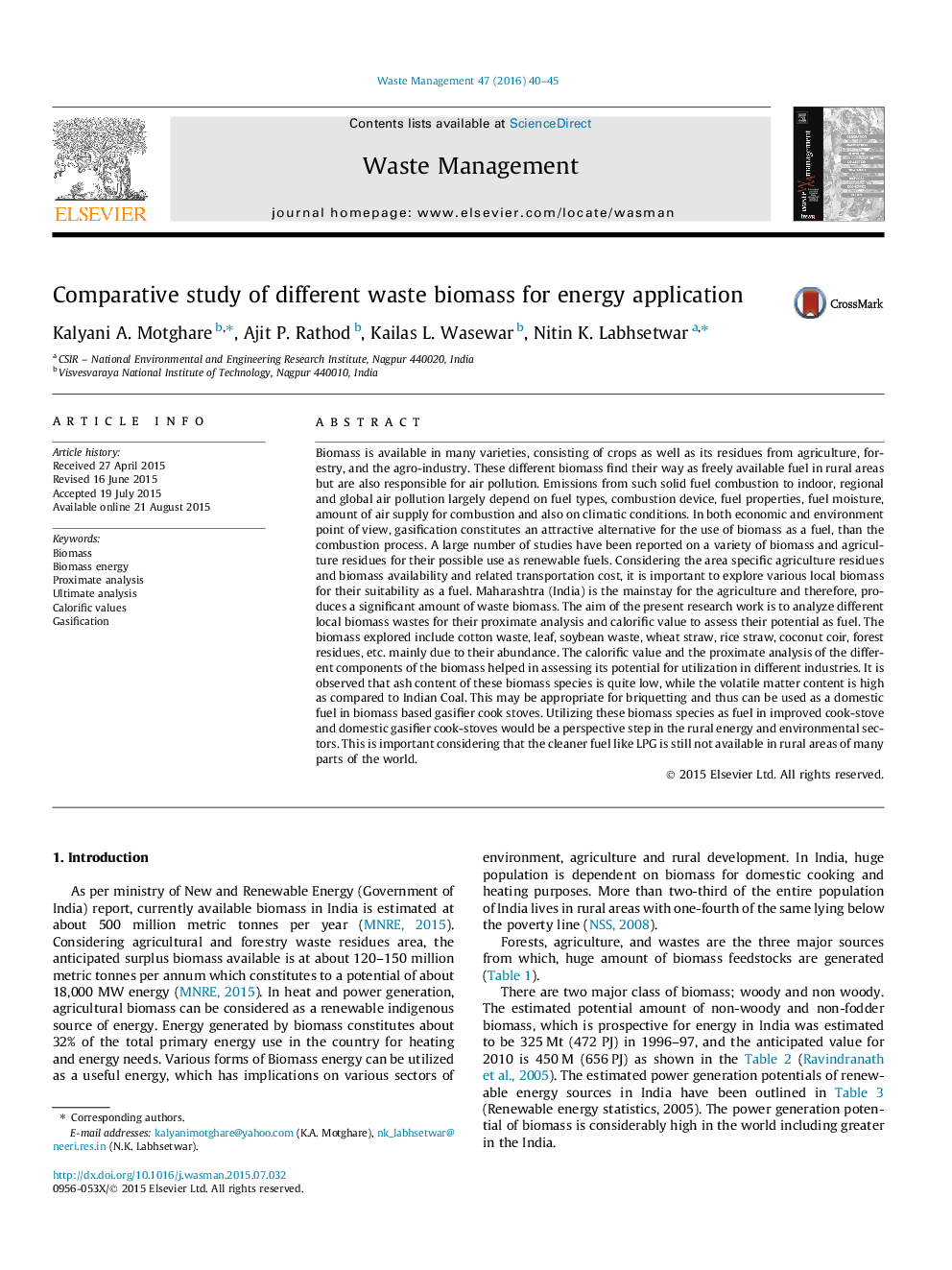| کد مقاله | کد نشریه | سال انتشار | مقاله انگلیسی | نسخه تمام متن |
|---|---|---|---|---|
| 4471327 | 1315017 | 2016 | 6 صفحه PDF | دانلود رایگان |
• Biomass is available in many varieties, consisting of crops as well as its residues from agriculture, forestry, and the agro-industry. In both economic and environment point of view, gasification constitutes an attractive alternative for the use of biomass as a fuel, than the combustion process.
• Maharashtra (India) is the mainstay for the agriculture and therefore, produces a significant amount of waste biomass. The aim of the present research work is to analyze different local biomass wastes for their proximate analysis and calorific value to assess their potential as fuel.
• From the proximate analysis, it was concluded that cotton waste and leaf have high volatile matter content with low ash content, thereby suggesting their potential to be used in place of fossil fuels. From elemental analysis it is found that all biomass samples contained almost equal amount of carbon (C), but cotton waste possess highest carbon content, low sulphur content.
• Heating values have been estimated using proximate and ultimate analysis. A comparison of the estimated and measured values of biomass species showed that the Boie equation predicted better results. Thus, studied biomasses, cotton waste, garden waste, soybean waste appear suitable as renewable and sustainable alternative sources to commonly used fossil fuels.
• Therefore, it is important to systematically study the calorific value, chemical composition and other parameters to assess the potential of such abundantly available local agricultural residues/biomass for rural energy applications in different parts of the world. Studies on locally available waste biomass are of significance, as cost of transportation for such fuels often makes such fuels unviable, thus suggesting their local use.
Biomass is available in many varieties, consisting of crops as well as its residues from agriculture, forestry, and the agro-industry. These different biomass find their way as freely available fuel in rural areas but are also responsible for air pollution. Emissions from such solid fuel combustion to indoor, regional and global air pollution largely depend on fuel types, combustion device, fuel properties, fuel moisture, amount of air supply for combustion and also on climatic conditions. In both economic and environment point of view, gasification constitutes an attractive alternative for the use of biomass as a fuel, than the combustion process. A large number of studies have been reported on a variety of biomass and agriculture residues for their possible use as renewable fuels. Considering the area specific agriculture residues and biomass availability and related transportation cost, it is important to explore various local biomass for their suitability as a fuel. Maharashtra (India) is the mainstay for the agriculture and therefore, produces a significant amount of waste biomass. The aim of the present research work is to analyze different local biomass wastes for their proximate analysis and calorific value to assess their potential as fuel. The biomass explored include cotton waste, leaf, soybean waste, wheat straw, rice straw, coconut coir, forest residues, etc. mainly due to their abundance. The calorific value and the proximate analysis of the different components of the biomass helped in assessing its potential for utilization in different industries. It is observed that ash content of these biomass species is quite low, while the volatile matter content is high as compared to Indian Coal. This may be appropriate for briquetting and thus can be used as a domestic fuel in biomass based gasifier cook stoves. Utilizing these biomass species as fuel in improved cook-stove and domestic gasifier cook-stoves would be a perspective step in the rural energy and environmental sectors. This is important considering that the cleaner fuel like LPG is still not available in rural areas of many parts of the world.
Journal: Waste Management - Volume 47, Part A, January 2016, Pages 40–45
